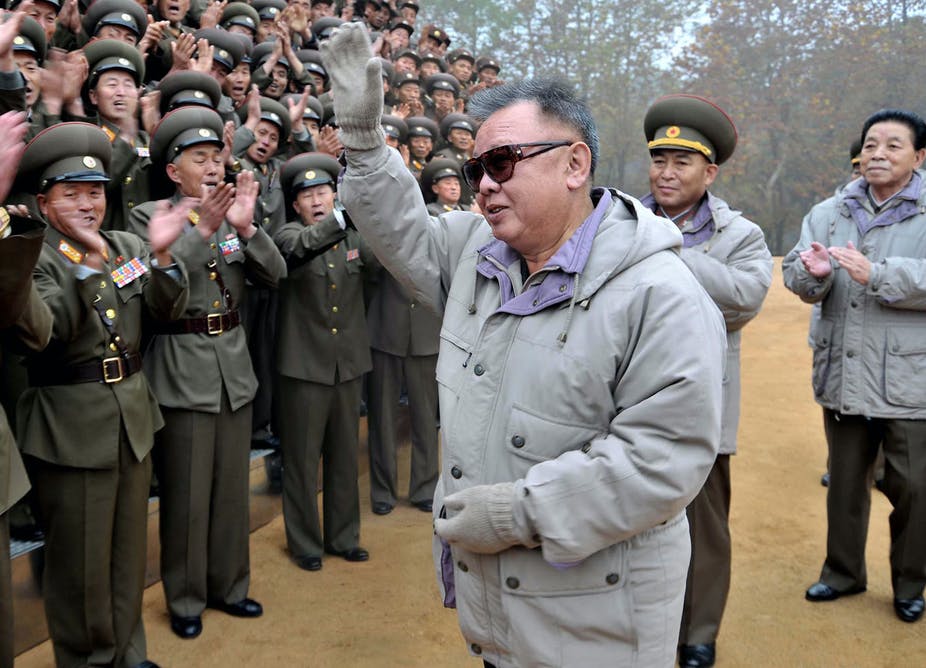“Do not speak badly of the dead.” So we are told by the ancient Greek scribe Diogenes Laertius. These are wise words, and in general I try to adhere to them. But I wonder whether Diogenes ever came across a man so worthy of condemnation as the recently deceased Kim Jong-Il.
Almost everything about him was fraudulent, starting with his father’s claim to be the kind-hearted founder of the Democratic People’s Republic of Korea. The truth is that in the final weeks of World War II, Kim Il-Sung was chosen by the Soviets to be their man in North Korea. He wasted no time in brutally purging the country of possible threats to his power. According to the hagiography later constructed by North Korean propagandists, Kim the Elder was a person with extraordinary abilities. He had—so they claimed—almost single-handedly kicked out the Japanese, created a unique and smooth-running socialist society, and had wisdom and virtue in abundance. These same supposed traits could also be found in one of his offspring, Kim Jong-Il, who succeeded him after his death in 1994. De facto power had been his for several years before he officially ascended the throne.
Kim the Younger was allegedly born in 1942 under miraculous circumstances at Mount Baekdu (considered by Koreans and Manchus as the place of their ancestral origin), when in fact he had a more prosaic birth (in 1941) at a Russian army base near Khabarovsk. Just as his father had been given dozens of honorific titles, Kim Jong-Il got many of his own, including “the heaven-sent hero,” “the great veteran of humanity,” “the paragon of loyalty,” “the ever-victorious commander” and “the fascinating statesman.”
Furthermore, Kim was said to have amazing mental and physical powers which allowed him to write the most beautiful poetry, average five holes-in-one per round of golf, change the weather, lead North Korea to unprecedented levels of affluence and glory, and earn the profound love and respect of his people. Other world leaders were awestruck by Kim’s brilliance and sought to emulate him.
Perhaps this is why he, as his father had done, employed on-the-spot guidance. The Kim personality cult became so ingrained that he would go wherever whim led him, pencil- and notepad-bearing entourage in tow, and ostensibly explain to experts how things should be done. This applied to poultry farms, shoe factories, artistic performances (none more so than the “mass games” for which Pyongyang was famous) and historians’ gatherings. Nothing was beyond his purview.
Let’s look at the facts. Kim Jong-Il did little to head off the North Korean famine which lasted for much of the 1990s. The number of deaths ranged from 900,000 to 3.5 million. It only ended—as if most citizens now have plenty to eat—when South Korea, China, the United States and other countries gave massive amounts of rice and other basic foods. (Kim himself never missed a meal, dining on the finest lobster, caviar and sushi.) This, of course, flew in the face of the “juche” (self-reliance) philosophy by which the DPRK claimed to operate.
I question everything about his tenure as the country’s leader. Who, after all, chose him as the No. 1 guy? His father. The military elites went along because they and their families had comfortable lives, unlike the large majority of citizens. Another trick he learned from Kim Il-Sung was having government agents scour the country for fresh-faced young women. Assuming they had done nothing to offend the regime, they were brought to Pyongyang and essentially became part of his harem. Kim Jong-Il is reported to have fathered some 70 children.
Much-needed money and energy were wasted on the construction of larger-than-life statues of Kim Il-Sung and Kim Jong-Il. There are thousands of them in that mysterious and cruel country north of the 38th parallel. Workmen were also dispatched to chisel self-glorifying slogans on the sides of nearly every mountain. “Comrades Kim Il-Sung and Kim Jong-Il are a great sun for the people” is but one example.
Kim was big on state-sponsored terrorism, including the 1983 bombing in Rangoon, Burma which killed 17 South Korean government officials, and the 1987 bombing of Korean Airlines flight 858; all 115 people on board perished. He sanctioned the kidnapping of numerous Japanese and South Koreans. More recently, he ordered or allowed the sinking of the ROK ship Cheonan (46 sailors dead) and the shelling of a South Korean island in the Yellow Sea. Under his guidance, North Korea became a nuclear state, enabling it to intimidate its southern neighbor.
And we must not forget the North Korean gulag—the system of prisons and prison camps where an estimated 200,000 people are held and forced to work under appalling conditions. Run afoul of the Kim regime and you, along with three generations of your family, would be sent to the most remote regions to toil and probably die.
This is by no means a complete list of Kim’s shortcomings as leader of the DPRK. If he had been a man of intelligence and vision, he surely would have perceived the need for reform, and I do not mean window dressing. He should have let the grass-roots markets flourish, abandoned the “military-first” policy, invited knowledgeable economic and industrial advisors to North Korea, and admitted the need for political changes. I am not so naive as to think he could have turned his creaky Stalinist state into a full-scale democracy overnight, but movement in that direction simply had to take place.
So what did he have to show for 17 years? Only that he managed to keep a tight grip on power and maintain the status quo, holding 23 million people hostage.


Add Comment